

Can't beat the heat: Before Justin Ashley, there was the tale of Jim Harnsberger
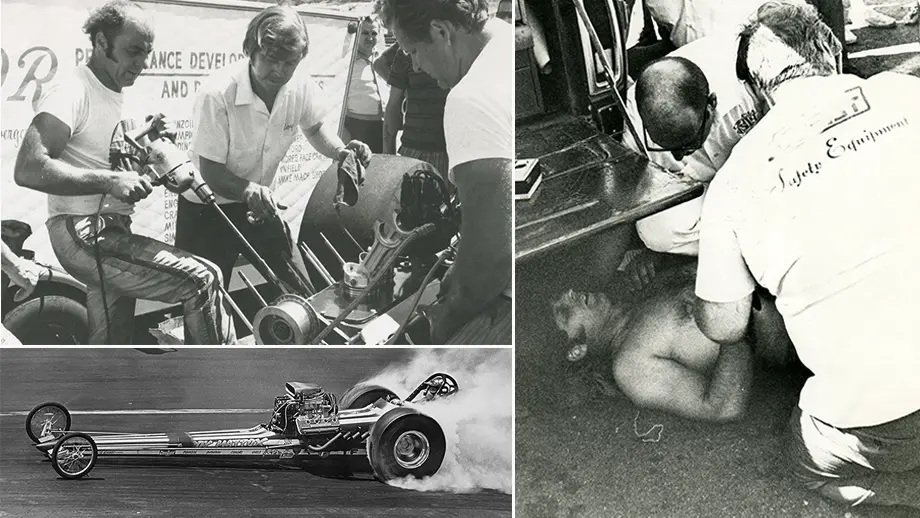
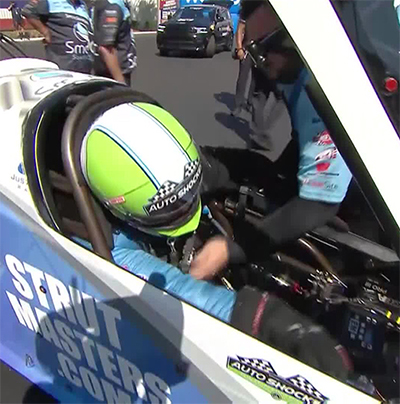
When Justin Ashley had to be pulled out of his car before the final round of Top Fuel at the summer Lucas Oil NHRA Winternationals presented by ProtectTheHarvest.com suffering from heat exhaustion, my brain instantly did that stupid/cool thing it always does: Try to place the crazy circumstances into the context of our sport's history.
In this case, the neural connection was almost instantaneous and the synapses fired on all eight cylinders, and I quickly blurted out, "It's Jim Harnsberger all over again," the nonsense-sounding sentence causing my less historically-steeped media-center colleagues to look askance at me as if perhaps I was experiencing my own heat-related deliriums.
Because I've written about it in passing at least twice over the years in this column, the fact that Harnsberger passed out in the pits at the '71 Summernationals while working on his car before the final round and could not make the call to race Arnie Behling was burned in my brain. The fact that it was almost exactly 50 years ago (plus two weeks) and happened at the race actually called the Summernationals and this was the cheekily rebranded (if in logo only) SummerWinternationals made the symmetry too good not to reference.
Yet, I knew only what I knew about it from the pages of NHRA National Dragster and Drag Racing USA: That he had beaten Don Garlits in round two and Herm Petersen in the semifinals, both on holeshots, and had a blown engine.

It was a typical hot, humid, and nasty Summernationals day, and Harnsberger was hard at work trying to cobble an engine together when he fell ill. And, as you can see in the photo here of Harnsberger’s pit, this is back in the day before teams had canopies to protect them from the elements or had the comforts of an air-conditioned lounge like Ashley had, and anyone who attended those July Summernationals can tell you how physically draining they were.
Harnsberger reportedly keeled over and was attended to by NHRA officials, was placed in an ambulance for a trip to the hospital, but still got back to the track to watch Behling single for the win.
That's already a great story, right? But you guys know me. Not good enough. What really happened?
A few minutes spent sleuthing on the internet got me to a Jeff Harnsberger who once lived in Urbana, Ill., like Jim. Surely, they must be related, but was Jim even still alive? After all, he'd be in his late 70s. A few Facebook messages and blind stab at a phone number I found elsewhere online connected me with Jeff, who, sure enough, is Jim's son, and quickly put me in touch with his dad, who is very much still alive and surprised (but delighted) to be remembered and called upon, and, at 77, has a keen memory.
Before we get to that sizzling Summernationals, first a bit about Harnsberger. Although his name was not well known at the time, he certainly was a well-rounded and experienced driver.
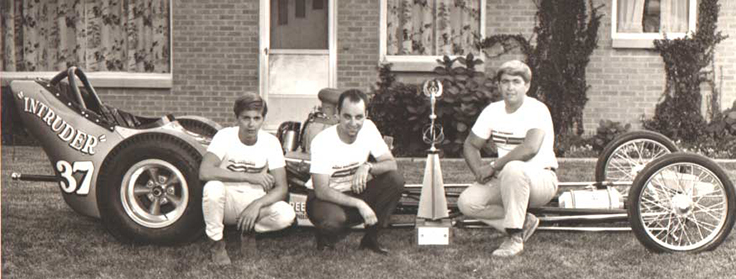
He had been an A/Fuel class winner at the 1965 U.S. Nationals over Donn Griffin in a car, dubbed The Intruder, that he ran with partner Larry Mingee. It had a 301 Chevy running on 20% nitro before moving into a full-fledged Top Fueler in 1966 using a Rod Stuckey chassis and a 364 Chevy.
They won some local meets, but larger success with the car eluded them as everyone else was switching to the all-conquering 392 Hemi, so they did, too, buying a Dave Zeuschel-built mill that they slotted into a Woody Gilmore chassis for a state-of-the-art package.
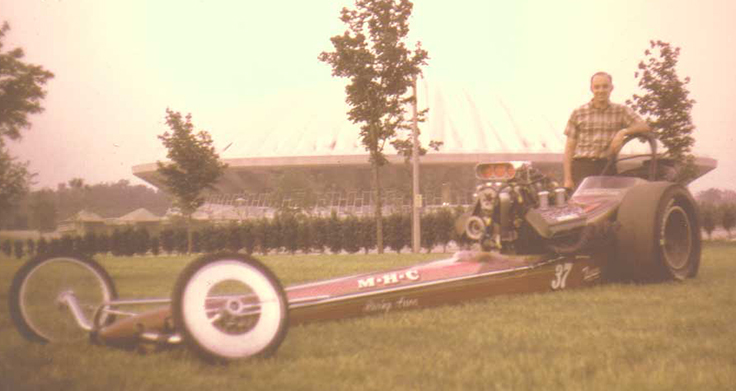
"We immediately went out and started running really good and set track records all over the Midwest," Harnsberger recalled. "Then, on May 25, 1969, we went to the final round at the AHRA Grand Nationals in Detroit. I lost the coin flip and got put in the right lane, which had a helluva dip at the 1,000-foot mark. I was running a friend of mine, Bob Murray out of St. Louis, and I put a three-car holeshot on him and had the race won. At the 1,000-foot mark, I felt the front end go down -– that's how bad the dip was -– and then it did a wheelstand. It happened in milliseconds, but it seemed like an hour.
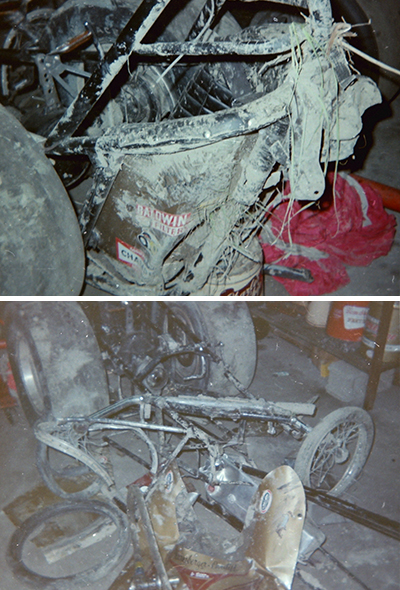
"I let out of the throttle, but it stayed up in the air because the air pressure was holding it up, and was trying to think, 'How can I get the front end down without crashing?' because I couldn't see where I was going. So I hit the parachute and the front end slammed to the ground. The front wheels broke off, the front axle broke, and I skated off the track and hit a 4x4 post that was about six feet off the side of the track. Hit it dead center. And, of course, that pulled the front of the car up in the air. I did about 10 cartwheels, and the car broke in half right behind the engine as it was designed to do to get the weight of the engine away from the driver.
"I ended up in a mud hole, upside down, buried about half a head deep, and didn't know if I was alive or dead. I pinched myself, and I could feel that, and I thought, 'Well, I must be alive,' but I couldn't see -– I didn't know I was buried in mud — but I heard people yelling to get the car turned over, so I knew I could hear. Once they got it turned over, I couldn't get out of the car; my ribs were hurting so bad. Turned out that I tore my diaphragm off the left rib cage. I could hardly breathe, so they took me to the hospital. I ordered a new car from my hospital bed and was back racing three months later."

Harnsberger ordered a new car with a better engine setback and ran the rest of '69 and '70 with partner Bob Cardiff before the cost of racing forced them out.
"We decided to hang it up or sell our parts and call it a day, then Roy Maddox, out of Terre Haute [Ind.], got ahold of me. He had a [Kent] Fuller car, and he ended up buying our engine, all our parts, and wanted me to drive for him in 1971. We went down to Gatornationals, and the very first run was a high six at 212 mph in a car that had never been out of the eights, so he was satisfied, and I was satisfied, so we kept racing together and ended up at the Summernationals."
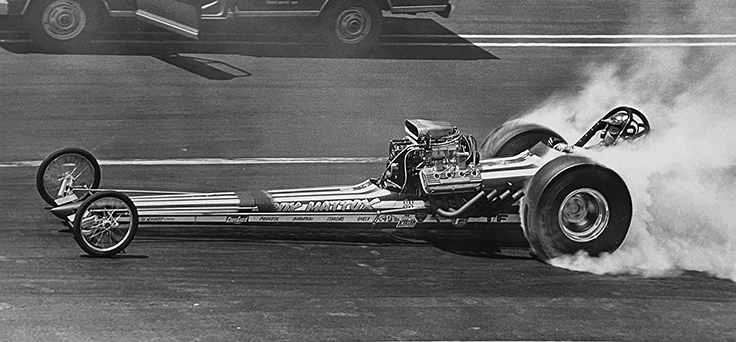
Harnsberger, fresh off a win at the Milan Dragway divisional event, qualified Maddox's purple-and-white striped "Ultimate Persuader" slingshot in the No. 15 spot, then upset Gatornationals champ Jimmy King with a 6.91 in the opening round to set up a date with "Big Daddy," who was at the wheel of his legendary and revolutionary rear-engined Swamp Rat 14 and had run 6.76 in round one.
"I just decided that I was going to try to cut the Tree as close as possible," said Harnsberger. "The way that I drove the car, if the clutch was right, the car would go straight down, and then shoot me out. I mean, it's like a slingshot. But the car always went straight down first, because you're wrinkling the tires. Then, they had the filaments in the bulbs [on the Christmas Tree] and you could see the filament, so when the filament just started to glow, I hammered the throttle, sidestepped the clutch, and I was gone."
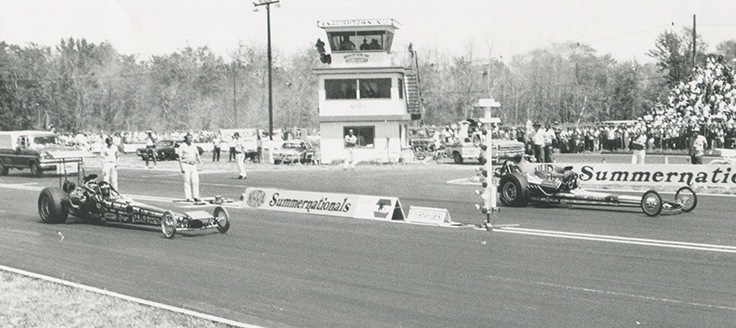
Harnsberger lit the win light, 6.76 to 6.69, to defeat Garlits then moved on to face low qualifier (6.661) Petersen, who had run 6.71 in his round-two victory. Harnsberger hammered the "Northwest Terror" with a gate job and advanced to the semifinals on a narrow 7.097 to 7.094 decision.
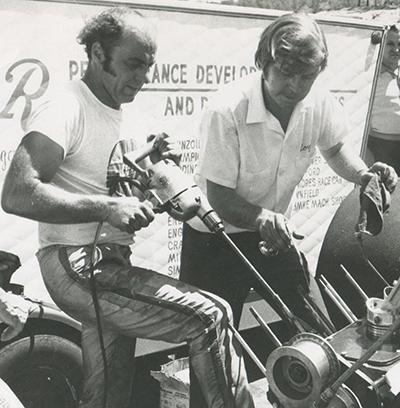
"I did the same thing to Herm that I did to Garlits, and he went up in smoke, but I threw a rod out," remembers Harnsberger. "We had burned a piston bad against Garlits and had to hone the walls and service the cylinder heads. Roy did the bottom end, and when we put the car on the ground, there's half of a brand-new rod bearing laying on the ground. Roy said it was a spare one from one of the boxes, and I've been a mechanic for years, and I've never seen a spare rod bearing in a box. So I'm thinking, 'Well, OK, if it's got oil pressure, I'll go ahead and run,' and if it's not going, well, I knew that he left a half a rod bearing out. We pushed down, and I had 80 pounds of oil pressure, but it was really knocking. I decided not to do a burnout and hope Herm red-lighted and I can just coast through. That didn't happen.
"I broke at the1,000-foot mark, and the engine locked up, so I found neutral on the clutch, and I coasted across first. We went back in the pits and, of course, the inside of the block's blown out and that motor's junk. A friend of ours came up and said we can take the motor out of his car and get it in our car and that I should take it easy and rest because it was just hotter than blazes out there. About that time I've started not feeling too good at all, and with all the pressure and anxiety and the heat and having sweated all day, they had me lay down underneath the tailgate of the pickup truck to get me out of the sun.

"Somebody come over, and he recognized the signs of heat prostration, and he said that I've got to get to the hospital right now. They put me in the back of the ambulance and packed ice all around me and were racing me to the hospital, and I'm hearing all these cars honking and tires screeching, so I lift up out of the [stretcher] and look down in front, and it's a two-lane road and [the ambulance] is running cars off the [side], going down the middle.
"We were about five miles from the track, but I said, 'Hey, stop this thing! I don't mind dying, but if I'm going to die, I'm going to die on a racetrack and not in the back of an ambulance. You either turn around and take me back for track or I'm going out the back door; one or the other, your choice.' They said, 'Once you get in an ambulance, you have to go to the hospital,' so I said, 'Fine, I'm going out the back door.' They turned around and took me back, and I got there just in time to see Behling run the final."
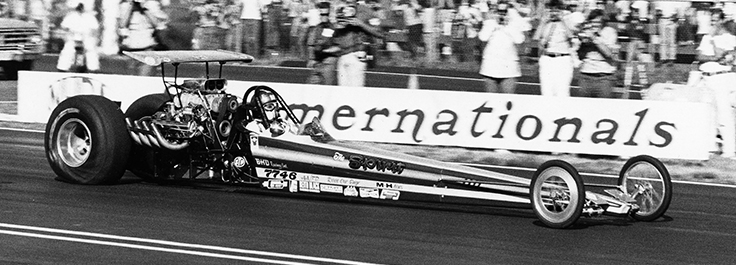
Behling, who had qualified Bruce Todd's Spirit entry No. 2 with a 6.663, ran a solid 6.69 in the final, so it's doubtful that Harnsberger would have beaten him, but stranger things have happened. Behling's win was just the second with a rear-engined Top Fueler, after Garlits' win at the Winternationals that year, but it made it even more clear that the handwriting was on the wall for the slingshot design.
Harnsberger recovered from his maladay and a month later won the Division 3 WCS at Tri-City Dragway, in Saginaw, Mich., and finished second in the eastern conference standings behind Jim Paoli. He even made it into "Hauler's Handicap" in National Dragster for the 1971 World Finals, where Tricky Tipster tongue-in-cheekly commented, "Long on driving skills, short on endurance."
The high cost of racing drove Harnsberger out for good at the end of 1972. He helped wrench for driver Kenny Safford on the Mr. Norm Funny Car for a few months before turning his attention to his growing automobile repair business.
"Racing was a high point in my life and, tell you the truth, I wouldn't change it for a thing, other than winning that final," he said. "That was my greatest chance to make a statement, you know, and dang it. Dang it. Dang it. Dang it. We got so close."
He did, and even though he didn't get what would have been a career-altering win, as Dragster Insider contributor Al Kean pointed out, maybe the circumstances of his runner-up even made his name more memorable than if he had been one of those sometimes forgotten one-hit wonders or the mostly forgotten one-time runner-ups, which is certainly a fair and accurate point.
Cruising through the photos from the '71 Summernationals, I came across a few interesting shots that I thought I would share with you to close out the column.
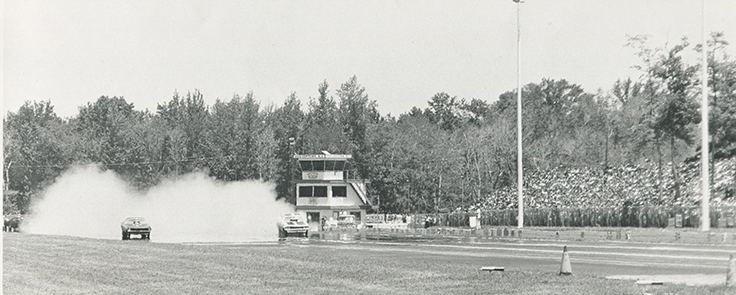
Back in 1971 (and for nearly two decades), Madison Township Raceway Park (later Old Bridge) didn't have any guardrails or guardwalls, which made it a photographer's dream.
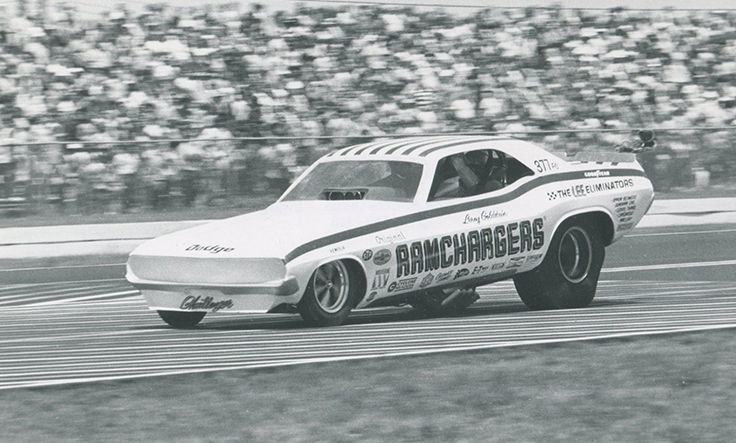
Ground-level shots like this, of Leroy Goldstein entering the traps, were so cool!
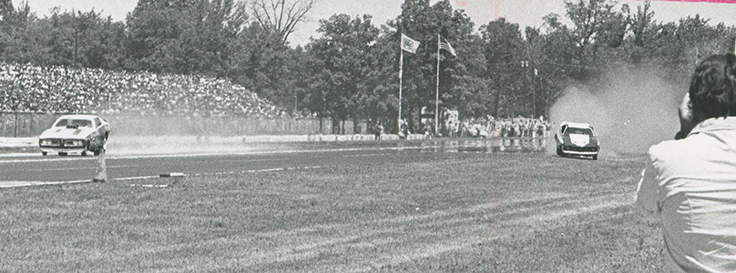
Of course, with no guardrails, it was easy to get off track, Just ask Omer "the Tentmaker" Carruthers and this gutsy photog.

As crazy as it sounds, for as hot as it got there in 1971, it actually rained on the first day of the event.
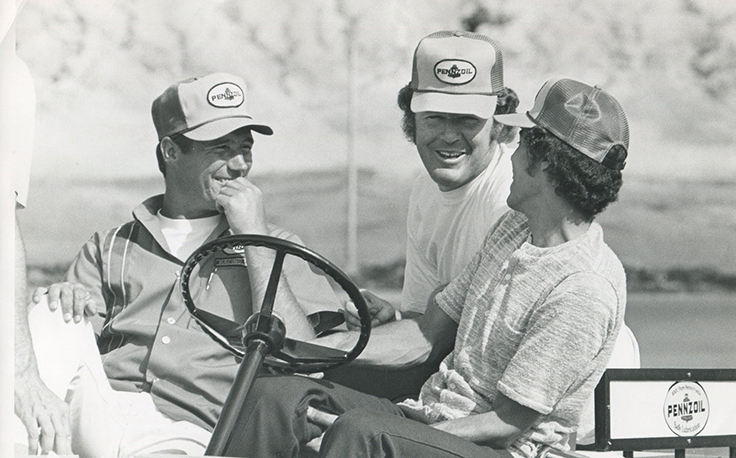
Tom "the Mongoose" McEwen, center, and Don "the Snake" Prudhomme were both on hand, seen chatting with Pennzoil's Bob Smith, but both had lousy outings.
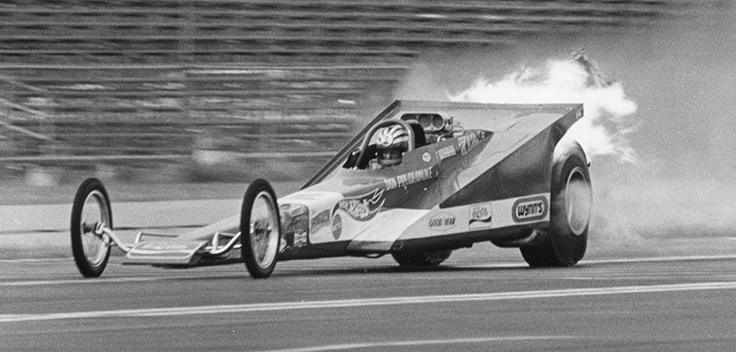
"Snake" had his still-new Hot Wheels Wedge on hand and qualified fifth with a 6.70 despite this inconvenient fire, then red-lighted against Dick McFarland in round one.

Larry Brown, who had won Top Gas at the Summernationals a year earlier and nine years later would runner-up to Shirley Muldowney in Top Fuel at the Springnationals, inventoried the parts for his new charge, Rick Weisenberger's Top Fueler.
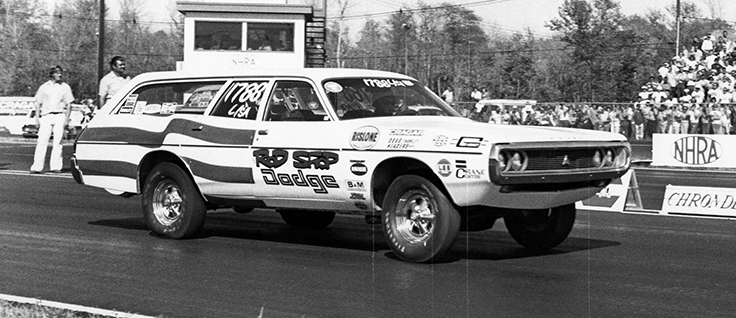
Judi Boertman made history, winning Stock by defeating her husband, Dave, in the first husband-wife final round in NHRA history.
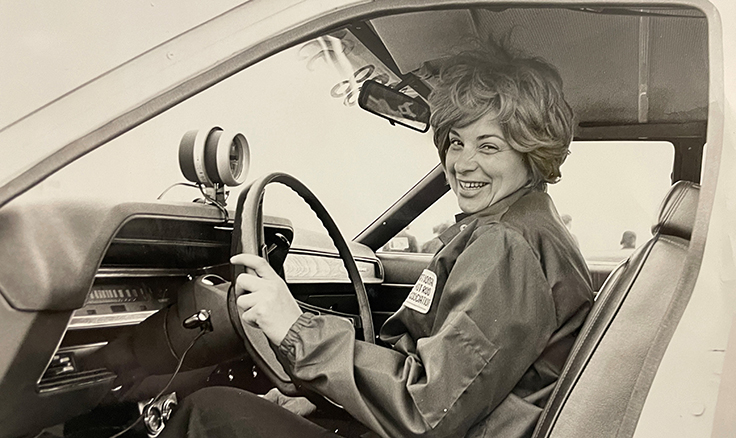
Boertman was just the second woman to win an NHRA national event title, on the heels of Shirley Shanan ('66 Winternationals).
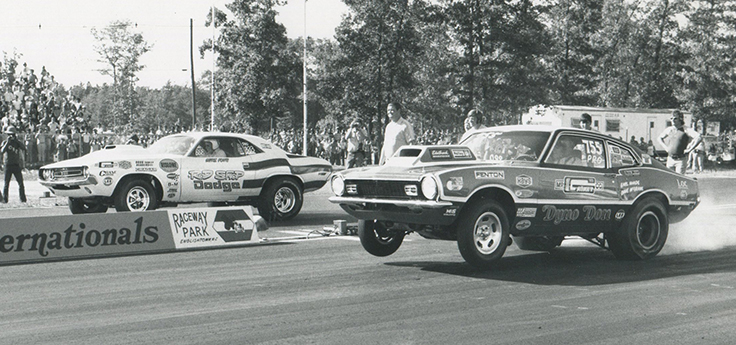
Ronnie Sox had won the first three Pro Stock racers of the season but, incredibly, suffered a flat tire before staging in round two, opening the door for "Dyno Don" Nichoson, near lane, to defeat Mike Fons in the final, 9.63 to 9.68.
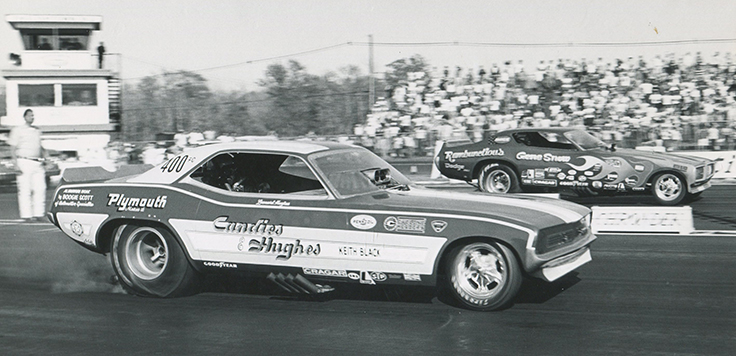
The Funny Car final came down to Leonard Hughes, near lane, and Gene Snow. Hughes, who later would become well known as the championship crew chief on the Candies & Hughes Top Fuelers, melted "the Snowman's" dreams of a win on a holeshot, 6.96 to 6.95.
OK gang, that's it. Thanks for putting up with the two-week column furlow while we got through the Western Swing. There's a lot of racing and a lot of travel in the weeks ahead until the end of the season, but I'll do my best to keep sharing the remarkable tales of our sport's history. Thanks, as always, for reading and sharing your thoughts with me.
Phil Burgess can be reached at pburgess@nhra.com
Hundreds of more articles like this can be found in the DRAGSTER INSIDER COLUMN ARCHIVE
Or try the Random Dragster Insider story generator



















































